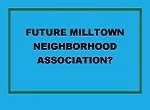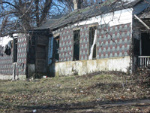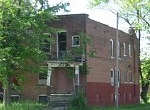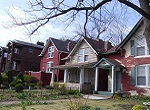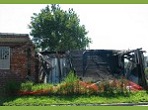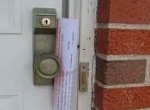Housing Decline Needs Quick Neighborhood Attention
Last Updated: May 30, 2024
To avoid housing decline, a high proportion of homes in a residential neighborhood need to be well maintained, regardless of whether the area is modest or splendid.
In a community forum that I led recently, someone asked why we thought they should be concerned about the condition of homes on private property. I answered that in short, community stability depends on housing that matches current demand and ability to pay. Competition quickly drives potential buyers to other parts of your city or region if both the public street area and the private homes in your neighborhood show neglect or disrepair, and that means lower property values.
If you are a victim of the spiral effect of decreasing property values, it's more important than ever to become involved in your neighborhood. When neighbors join together to insist on enforcement of maintenance codes and to find resources to help others invest in the maintenance and updating of the housing, good things happen.

So neighborhoods should watch their most important asset,
neighborhood quality as indicated by housing maintenance, very
carefully. If you want to avoid housing decline, characteristics to
monitor include:
- Vacancy rate. A healthy rate in most circumstances is considered to be about 5%. If the vacancy rate is much lower than 5%, people do not have enough choices in housing. A higher rate indicates likely housing decline based on over-supply or lack of market interest. This vacancy rate rule-of-thumb is market-specific too. If your neighborhood has a large number of similar homes, 5% may be way too many vacancies. If your city is booming, and yet your neighborhood vacancy rate is higher than that in other neighborhoods, you will experience stagnant property values.
- Housing tenure. This is the technical term for whether housing is occupied by owners or renters. An owner-occupied residential neighborhood is likely to be much more stable, exhibit less turnover, and show the fruits of more pride of ownership. Unkempt rental units can quickly lead to general housing decline, especially when owners do not live in your neighborhood or you cannot learn the identity of the true owner due to their hiding behind an LLC (limited liability corporation) form of ownership.
- Trend in age and household composition of occupants. A new subdivision often attracts people of approximately the same age, and if those people remain in place, eventually you'll have a group of older adults who are ready to leave their homes at about the same time. If retirees neglect maintenance, this factor alone can lead to housing decline. So neighborhood demographic trends are worth watching. ("Demographic" is a term that means population-related.)
- Relevance of the housing stock to the type of housing in demand. This factor includes age, architectural style, size, number of bedrooms and bathrooms, availability of closet and garage space, off-street parking, and access to shopping, parks, and community facilities. When low-value homes are not updated to reflect current tastes (such as carpet versus hardwood floors, wallpaper or none, open concept or not), a downward spiral in property values is likely to follow suit. In higher-value neighborhoods, new owners typically will spend the money to update aesthetics to fit today's trends, so the problem occurs in the less popular neighborhoods.
- Proximity of the neighborhood to jobs. If the only employer in the immediate area offers only white collar jobs and salaries, the housing types and price ranges should match. Or if fast food jobs are almost the only jobs nearby, the housing should probably be more modest.
- Affordability to an ample market of households that would like to live in the vicinity. Even the most luxurious residential neighborhood will languish if people can't afford to live there.
- Maintenance level. A residential neighborhood needs to show a high percentage of well-maintained homes to remain competitive. Since this is a free market society, it's important to remember that each neighborhood is in fact competing with dozens of choices for many households.
Only a couple of poorly maintained residences taint a block, and a few blocks showing mixed levels of maintenance means that housing decline has arrived.
To begin to see how bad housing decline is in a particular area, take advantage of available objective information.
If you have a local
planning office or extension office, by all means ask them to obtain and
analyze your housing data. Pester your planning department to do a
customized housing inventory. Sometimes these are called housing
condition surveys. On our page about this topic, we have even given you some tips for performing your own informal survey.
You also can obtain statistics on housing violations from your code enforcement department, if your city does code enforcement.
Every other year, in odd-numbered years, the U.S. Department of Housing and Urban Development conducts the American Housing Survey, which collects overall housing data on some metropolitan areas. If your city was surveyed recently, you can compare your local neighborhood data to regional trends. The American Housing Survey is fairly unique among data tools on housing, in that it documents when housing is demolished or otherwise taken out of service. Unfortunately, this survey does not allow you to disaggregate (pull apart) data for areas smaller than a metropolitan area.
How to Reverse Housing Decline
A mild case of the blahs in the maintenance of your neighborhood might be cured by a robust effort in neighborhood marketing. Check out the Center for Community Progress tips on conducting a neighborhood marketing campaign.
If something more serious is involved in addition, though, policy makers at the community level need to decide what incentives for private investment they can offer. That might be anything from marketing to offering financial incentives or publicizing state tax credits for reinvestment.
A municipal government also can invest in capital improvements, such as street or sidewalk repairs, street trees, street lighting, trails, local playgrounds, or streetscape to attempt to make the neighborhood more attractive.
If maintenance and remodeling are needed, the government can streamline the building permit process, offer seminars on common repairs or remodeling projects, assemble a tool lending library, or perhaps administer low-interest loans in a part of the city that qualifies for the use of federal Community Development Block Grant money in the U.S. Many other nations have robust programs to allow for property rehabilitation.
Depending on the state, it may be possible to offer additional incentives. Older housing may qualify for historic building reinvestment credits. It may be possible to form a neighborhood improvement district.
If a community has dominant employers on its outskirts, but is suffering from housing decline, it may be possible for the employers to provide capital to start a community development corporation that then would make low-interest loans and offer technical assistance for repairs in the nearby residential neighborhood. Of course there are other ways to capitalize a CDC too, so if you are interested in that option, be sure to check out that page.
When demand is insufficient, by the way, occasionally nearby employers will offer employee incentives to purchase homes in the neighborhood. Such a program helps employees, but also preserves surrounding property values and prestige for the employer.
If many homeowners are older and unable to address housing decline, it may be possible to organize college students or other volunteers for an occasional blitz day in which painting, caulking, securing porch floor boards, and other periodic maintenance activities are brought up to date. You also could approach corporations in your part of the city about allowing employees to volunteer for a day.
If market demand appears to be adequate, but maintenance is inadequate, the municipality should probably undertake a concentrated code enforcement sweep through the neighborhood, taking a few blocks a year if need be.
In the situation where market demand is inadequate, pause to think about whether code enforcement will make the situation better or worse. Code enforcement could be just cruel if most homeowners don't have the money to address their code violations. So in these situations, try to pair enforcement programs with sufficient rehab and repair grants and loans from either a governmental source or a community-minded bank or group of banks.
In the home metro area of one of our writers, St. Louis, it's popular for municipalities to require what is called an occupancy permit when a home or apartment changes occupants. An exterior and interior inspection is performed, and before a new occupant is allowed, all violations of the current code must be corrected. Who pays for the correction is often a subject of negotiation in the real estate deal.
The positives of this system are that it does stem housing decline, providing there are enough changes in occupancy. It also accomplishes periodic updating of housing, particularly with regard to changing electrical needs and ever more sophisticated safety considerations.
The negative is that if many owners stay in their homes for 25 years, other code enforcement programs also will be needed if the exterior is neglected.
Reducing the Number of Housing Units in Buildings
Another issue that caused housing decline in large cities in times of housing shortage, particularly in the wake of the high rate of new household formation after World War II, was conversion of large homes into apartments.
Sometimes in profitable markets, spacious apartments are converted into smaller apartments in the chase for an even larger profit.
If you have too much multi-family housing for current demand, try to convert some of it back to larger units, including single-family homes if possible.
On the other hand, if you have a neighborhood of very large older homes that is beginning to show signs of housing decline, the architecture might make it possible for you to convert those homes into two- or three-family units. Try to make them condominiums if you can.
To the extent people in your community can afford home ownership, cultivate that. It does make for a greater investment of time, talent, and pride in the community.
I hasten to add that returning housing to large individual units is not at all appropriate in every instance. In many places the need for affordability in housing is so great that smaller units are to be encouraged, not larger ones. So like almost everything in community work, be sure you are applying a technique that is appropriate for your own geography.
If the Neighborhood Is Deteriorating
City governments often take a paternalistic stance toward neighborhoods, but in most regions they can't afford this attitude any longer. The neighborhoods make up the city, and if the neighborhoods show signs of housing decline, the process of reversing the situation can be very costly indeed.
Not only is the financial cost greater the longer maintenance is deferred, but also the difficulty in creating a positive buzz multiplies as small maintenance issues remain unaddressed.
Towns, cities, and rural areas must address any tendency toward housing decline immediately. Most communities can absorb a few eyesores and a few mistakes, but don't let a situation get out of hand before you act.
Special Problems That Lead to Lack of Homeowner Investment
It's tough to maintain neighborhood quality when a large amount of student housing is situated nearby. Just do the best you can to work with the college or university, and try to get them to accept some responsibility for the situation. Perhaps they can have a minimum maintenance standard for apartments they recommend or list for their students.
Work with the landlords directly, since probably they are making a nice profit on their student apartments. The municipal government may have to use its leverage in this situation as well.
Another jarring development can be a large influx of immigrants or refugees of other than the dominant ethnicity. Sometimes the cultural characteristics of one group are highly offensive to another group.
In one city the habit of large and loud family gatherings on the front lawn on Sunday afternoons threatened a community revolt. At the other end of the spectrum, it's very common for rural residents to become very upset, and probably justifiably so, when city dwellers move to the country and then demand not to be awakened by the crowing of the roosters.
Just remember that housing decline becomes harder to reverse as it progresses. And housing decline and neighborhood decline can't be separated.
Use that certainty with your local government and with any local institutions that are invested in the neighborhood to try to rally all the assistance possible in creating an upward spiral rather than a downward one.
Next Steps in Working on Neighborhood Housing Quality
- Making and Keeping a Good Community >
- Housing Isues > Dealing with Housing Decline
Join GOOD COMMUNITY PLUS, which provides you monthly with short features or tips about timely topics for neighborhoods, towns and cities, community organizations, and rural or small town environments. Unsubscribe any time. Give it a try.
